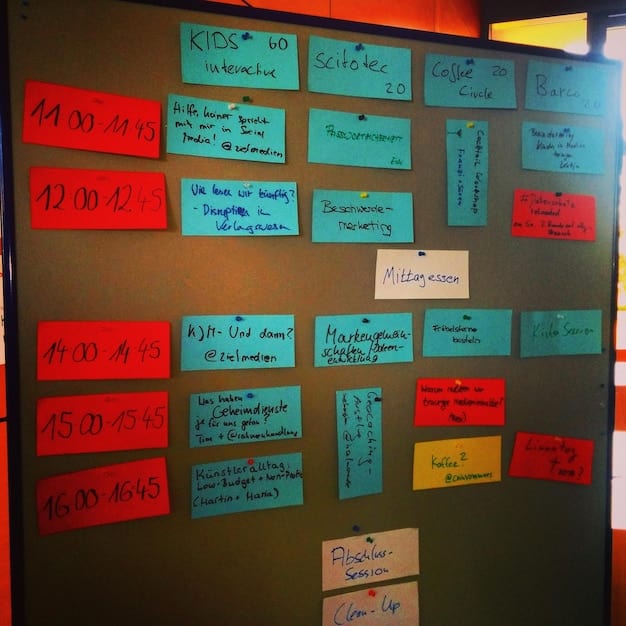Mastering Keyword Research for 2025: A Practical Guide

Achieving proficiency in keyword research by 2025 demands a blend of advanced analytical tools, deep audience understanding, and continuous adaptation to evolving search engine algorithms to uncover high-impact, actionable search terms that drive targeted organic traffic.
In the dynamic realm of digital marketing, the ability to effectively master the art of keyword research for 2025 stands as a cornerstone for online visibility and sustained growth. This comprehensive guide will equip you with the practical solutions and forward-thinking strategies required to navigate the complexities of search engine optimization, ensuring your content resonates with your target audience and ranks prominently.
The Evolving Landscape of Keyword Research in 2025
Keyword research has always been the foundation of any successful SEO strategy, but its evolution accelerates with each passing year. In 2025, the landscape is more nuanced, moving beyond simple volumetric analysis to encompass user intent, topical authority, and semantic relationships. Understanding these shifts is crucial for any digital marketer aiming to stay ahead.
The days of merely stuffing keywords are long gone. Search engines, particularly Google, have become incredibly sophisticated, prioritizing natural language processing and context over exact-match phrases. This means your research must reflect how real people speak and search, not just rely on automated tools telling you what the “best” keywords are based on vanity metrics.
Beyond Volume: Prioritizing User Intent and Semantic Search
At the heart of the evolution of keyword research is the emphasis on user intent. It’s no longer enough to know what people search for; you must understand why they are searching. Are they looking for information, navigation to a specific site, a transaction, or considering a purchase? Each intent requires a different approach to content creation and keyword targeting.
- Informational Intent: Users seeking answers to questions or general knowledge.
- Navigational Intent: Users looking for a specific website or brand.
- Transactional Intent: Users ready to make a purchase or complete an action.
- Commercial Investigation: Users researching products or services before a purchase.
Semantic search plays a pivotal role here. Search engines now understand the meaning behind queries rather than just matching keywords. This means grouping keywords into thematic clusters and building topical authority around broad subjects is more effective than optimizing for individual, isolated terms. This holistic approach ensures your content is comprehensive and provides value across the entire user journey.
Leveraging AI and Machine Learning in Keyword Discovery
Artificial intelligence and machine learning are no longer futuristic concepts; they are embedded in contemporary keyword research tools. These technologies can process vast amounts of data, identify emerging trends, predict search behavior, and even suggest long-tail variations that human analysis might miss. Integrating AI-powered tools into your workflow can significantly enhance the efficiency and accuracy of your research.
However, it’s vital to remember that AI is a tool, not a replacement for human insight. While AI can analyze patterns and data, the interpretive power and strategic thinking remain with the marketer. The challenge is to ask the right questions and apply the AI-generated insights effectively. Predictive analytics, for instance, can help identify keywords poised for growth, allowing you to create content proactively.
In summary, the 2025 keyword research landscape demands a shift from volume to intent, from isolated terms to semantic clusters, and from manual processes to AI-augmented strategies. This prepares marketers to create content that not only ranks but genuinely serves the user.
Advanced Strategies for Uncovering High-Value Keywords
Moving beyond the basics of keyword research means delving into more sophisticated techniques to unearth opportunities that your competitors might overlook. These advanced strategies focus on competitive analysis, long-tail opportunities, and tapping into niche markets with precision.
Traditional keyword tools offer a starting point, but true mastery comes from applying a deeper analytical lens. This involves looking at data patterns, understanding competitive gaps, and anticipating future search trends. The goal is to find queries that are both relevant to your audience and offer a strong chance of ranking.

Competitive Keyword Gap Analysis
A crucial advanced strategy is performing a competitive keyword gap analysis. This involves identifying keywords that your direct competitors are ranking for, but you are not. By analyzing their successful content and keyword portfolios, you can uncover hidden opportunities and develop strategies to capture that traffic.
Tools like SEMrush, Ahrefs, and SpyFu are indispensable for this. They allow you to:
- Identify competitor top-performing keywords: See which keywords drive the most organic traffic to their sites.
- Analyze their content strategy: Understand what types of content they’re creating around those keywords.
- Discover their backlink profile: See who links to their content, potentially revealing further collaboration or content promotion opportunities.
This analysis not only reveals what’s working for others but also highlights the gaps in your own content strategy. It’s about learning from their successes and failures to inform your own approach. Don’t just copy; innovate and improve upon their existing content.
Unlocking the Power of Long-Tail Keywords
While head terms (short, broad keywords) often boast high search volumes, they are also highly competitive. Long-tail keywords, on the other hand, are longer, more specific phrases that typically have lower search volumes but much higher conversion rates due to their specific intent. They are the backbone of a robust, future-proof SEO strategy.
Think of it this way: someone searching for “running shoes” is early in their journey. Someone searching for “best lightweight trail running shoes for wide feet” knows exactly what they want. Targeting these specific queries allows you to connect with users closer to the point of conversion.
Techniques for finding long-tail keywords include:
- Google Autocomplete and “People Also Ask” boxes: These provide direct insights into related user queries.
- Forum and Q&A sites (e.g., Reddit, Quora): Real people ask real questions here, often in long-tail formats.
- Keyword research tools with question-based keyword filters: Many tools can now specifically identify questions users are asking.
The beauty of long-tail keywords is their cumulative effect. Individually, they may drive little traffic, but collectively, they can account for a significant portion of your organic search traffic, often with higher conversion rates due to the clarity of intent. They represent less competition and higher relevance.
By integrating competitive analysis and a dedicated focus on long-tail opportunities, marketers can uncover high-value keywords that align with user intent and yield superior results compared to broad, highly competitive terms. This precision in targeting is key to maximizing ROI in 2025.
Tools and Technologies Revolutionizing Keyword Research
The efficacy of keyword research in 2025 heavily relies on the sophisticated tools and technologies available. These platforms automate much of the data collection and analysis, allowing marketers to focus on strategic insights rather than manual sifting. From comprehensive suites to specialized AI-driven platforms, selecting the right tools is paramount.
Gone are the days when a simple Google Keyword Planner would suffice for competitive insights. Today’s tools integrate machine learning, predictive analytics, and vast datasets to offer a granular view of the search landscape. Understanding how to leverage these effectively can give you a significant edge.
Essential Keyword Research Software Suites
Comprehensive SEO suites remain the cornerstone of professional keyword research. Tools like Ahrefs, SEMrush, and Moz Keyword Explorer offer an array of features that go beyond basic keyword suggestions. They provide competitive analysis, backlink data, site audits, and content gaps, all vital for a holistic SEO strategy.
- Ahrefs: Renowned for its extensive backlink index and robust keyword database, allowing for deep content and competitor analysis. Its “Content Gap” feature is particularly useful for finding missed opportunities.
- SEMrush: A versatile all-in-one platform offering detailed keyword insights, competitive research, PPC data, and content marketing tools. Its “Keyword Magic Tool” can generate thousands of keyword ideas.
- Moz Keyword Explorer: Provides metrics like “Organic Difficulty” and “Opportunity” to help prioritize keywords, along with competitive metrics specifically designed to help target less competitive terms with potential for higher impact.
While these tools come with a subscription cost, the value they provide in terms of time saved and depth of insight is significant for any serious digital marketing endeavor. They equip you to make data-driven decisions that translate into tangible results.
Leveraging AI-Powered Predictive Analytics Tools
The next frontier in keyword research involves AI-powered predictive analytics. These tools use machine learning algorithms to analyze historical search data, current trends, and even external factors (like global events or economic shifts) to forecast future search behavior and identify emerging keywords before they become highly competitive.
For instance, some AI platforms can identify micro-trends in user queries, suggesting long-tail phrases that are gaining traction but haven’t yet reached peak popularity. This proactive approach allows marketers to create content well in advance, establishing authority early in a trending topic.
Examples of such tools, or features within existing suites, are:
- Topic modeling: AI identifies broader themes within user searches, suggesting comprehensive content clusters.
- Trend forecasting: Predicting the rise or fall of certain keywords based on patterns and external data.
- Intent classification: Automatically categorizing keywords by user intent, streamlining content strategy.
While the full potential of AI in keyword research is still unfolding, integrating these intelligent capabilities allows for a more agile and forward-looking strategy. It shifts the focus from merely reacting to current trends to proactively shaping your content strategy based on anticipated user needs. The combination of comprehensive suites and predictive AI is indispensable in 2025.
Integrating Keyword Research with Content Strategy
Keyword research is not a standalone activity; it’s the compass that guides your entire content strategy. In 2025, the seamless integration of keyword insights into content creation, optimization, and distribution is crucial for achieving high rankings and driving meaningful engagement. This means moving beyond keyword insertion to truly intent-driven content planning.
The best keywords are useless if they don’t inform the kind of content you produce. Effective integration ensures that every piece of content published serves a specific user need and targets a particular set of keywords, leading to higher organic visibility and better user satisfaction.
Mapping Keywords to the Buyer’s Journey
A strategic approach involves mapping keywords to different stages of the buyer’s journey: awareness, consideration, and decision. By understanding where a user is in their journey, you can select keywords that match their intent and provide the most relevant content, guiding them closer to conversion.
- Awareness Stage: Focus on informational keywords (e.g., “what is content marketing,” “how to improve SEO”). Content types best suited are blog posts, guides, and infographics.
- Consideration Stage: Target commercial investigation keywords (e.g., “best SEO tools,” “marketing software comparison”). Content should include reviews, comparisons, and case studies.
- Decision Stage: Utilize transactional keywords (e.g., “buy [product name],” “[service] pricing”). Landing pages, product pages, and free trials are ideal here.
This structured approach ensures that your content addresses users at every touchpoint, building trust and authority as they progress. It moves beyond simply ranking for keywords to actually facilitating the user’s path toward conversion.
Content Clusters and Topical Authority
In 2025, Google’s algorithms continue to favor websites that demonstrate deep topical authority. This means organizing your content into “clusters” around broad subjects rather than creating isolated articles. A “pillar page” covers a broad, high-level topic, while multiple “cluster content” pieces delve into specific sub-topics, all linked internally to the pillar page.
For example, if your pillar page is “Digital Marketing,” cluster content might include “Email Marketing Best Practices,” “SEO for Small Businesses,” and “Social Media Strategy.” All these cluster articles would link back to the main “Digital Marketing” pillar page, signaling to search engines your comprehensive coverage of the topic.
This strategy not only helps in ranking for a wider range of related keywords but also improves user experience by providing a clear, intuitive navigation path through logically related content. It also establishes your site as a go-to resource for a particular subject, boosting your overall domain authority.
Effective integration means that keyword research isn’t just about finding terms; it’s about structuring your entire content ecosystem to provide maximum value to users and signify expertise to search engines. By mapping keywords to the buyer’s journey and building topical authority through content clusters, marketers can create a powerful and cohesive online presence.
Measuring Success and Adapting to Algorithmic Shifts
The job of a keyword strategist doesn’t end once content is published. In the ever-changing world of SEO, continuous measurement and adaptation are paramount. Monitoring keyword performance, analyzing traffic patterns, and staying abreast of algorithmic updates are essential to maintain and improve search rankings in 2025.
Without proper tracking and analysis, even the most meticulously researched keywords can fail to deliver anticipated results. This often means iterating on your initial content, refining your targeting, and responding quickly to changes in search engine behavior or user preferences.
Key Performance Indicators (KPIs) for Keyword Success
To truly understand the impact of your keyword strategy, you must define and track relevant KPIs. These metrics provide clear insights into what’s working and what needs adjustment. Focusing solely on rankings can be misleading; focus on the business impact of your keywords.
Critical KPIs include:
- Organic Traffic: The total number of visitors coming to your site via organic search for specific keywords.
- Keyword Rankings: Your position in search engine results pages (SERPs) for targeted keywords. Track both high-volume and long-tail terms.
- Conversion Rate: How many visitors coming from specific keywords complete a desired action (e.g., purchase, sign-up). This is the ultimate measure of ROI.
- Click-Through Rate (CTR): The percentage of impressions that result in a click, indicating the attractiveness of your meta-title and description.
- Bounce Rate and Time on Page: Indicate user engagement and content relevance, suggesting whether your content meets user intent.
Regularly reviewing these KPIs in tools like Google Analytics and Google Search Console helps identify trends, pinpoint underperforming keywords, and highlight content opportunities. It’s about optimizing for user engagement as much as it is for search engine algorithms.
Staying Ahead of Algorithmic Updates
Search engine algorithms, particularly Google’s, are constantly evolving. Major updates can significantly impact rankings, making it crucial for keyword strategists to stay informed and adapt their approaches swiftly. While specific details of algorithms are rarely disclosed, their impact on SERPs and user behavior is observable.
Strategies for staying ahead include:
- Following industry news and reputable SEO blogs: Sources like Search Engine Journal, Search Engine Land, and Google’s official blog provide timely updates and analyses.
- Monitoring rank trackers and traffic analytics closely: Sudden drops or spikes can signal an algorithmic shift impacting your site.
- Focusing on first principles: Algorithm updates often reinforce existing best practices: user experience, high-quality content, and technical SEO. Building a strong foundation makes your site more resilient to changes.
- Testing and iterating: Don’t be afraid to experiment with your content and SEO tactics based on new insights.
The goal is not to chase every minor change but to understand the broader direction of algorithmic evolution, which consistently leans towards rewarding valuable, human-centric content. By continuously measuring relevant KPIs and adapting to algorithmic shifts, your keyword strategy will remain robust and effective, driving consistent organic growth in 2025 and beyond.
Future-Proofing Your Keyword Research for Longevity
As the digital landscape evolves at an unprecedented pace, future-proofing your keyword research strategy is no longer optional; it’s a necessity. This involves adopting approaches that anticipate changes in search behavior, technology, and algorithmic priorities, ensuring your efforts remain relevant and impactful for years to come.
The aim is to build a keyword strategy that isn’t just effective for today but also resilient against future shifts, whether they involve new search interfaces, voice search advancements, or more sophisticated AI-driven algorithms. Longevity comes from adaptability and a foundational understanding of user needs.
Embracing Voice Search and Conversational AI
Voice search and conversational AI are rapidly growing segments of the search market. People interact with virtual assistants (like Siri, Alexa, and Google Assistant) using natural, conversational language, which differs significantly from traditional text-based queries. Future-proofing your keyword research means optimizing for these conversational patterns.
Consider the difference: a user might type “best Italian restaurants NYC,” but say “Hey Google, where’s the best Italian place near me for dinner tonight?” Voice queries are often longer, more question-based, and localized. Optimizing for voice involves targeting:
- Question keywords: “Who,” “what,” “where,” “when,” “why,” “how” phrases.
- Local SEO: Ensuring your business information is accurate and fully optimized for “near me” searches.
- Natural language: Creating content that flows conversationally and directly answers common questions.
This shift requires a move towards more semantic and long-tail keyword variations that mirror everyday speech. Featured snippets and concise, direct answers also become critically important as they often hold the prime spot in voice search results.
Anticipating Visual Search and Metaverse Implications
While still nascent in widespread application, visual search (using images to initiate searches) and the emerging metaverse environments present new frontiers for keyword research. Though text-based keywords may not apply directly to these formats, the underlying intent remains crucial, and the way users “search” for information or products will evolve.
For visual search, the optimization focus shifts to:
- Detailed image alt text and captions: Describing image content accurately for search engines.
- Structured data for images: Providing context and helping images appear in relevant visual search results.
- Product catalogs with high-quality, diverse imagery: Essential for e-commerce in a visual search world.
The metaverse, while speculative for keyword research, suggests a future where search might involve navigating 3D spaces to find information or products. This could imply “spatial keywords” or optimizing virtual objects for discoverability. While concrete strategies are still forming, understanding the potential for new search paradigms is key to future adaptation.
Ultimately, future-proofing your keyword research for longevity means fostering a mindset of continuous learning and adaptation. By embracing new search interfaces like voice and anticipating emerging technologies like visual search and the metaverse, you ensure your strategy remains pliable and effective, ready for whatever the digital future holds.
Practical Implementation: A Step-by-Step Guide for 2025
Transitioning from theoretical understanding to practical application is where true mastery of keyword research lies. This section provides a step-by-step guide, integrating all the concepts discussed, to help you implement a robust and effective keyword strategy for 2025. It’s about building a repeatable process that yields consistent results.
A structured approach ensures that no critical steps are missed and that your efforts are always aligned with your overarching business objectives. This practical roadmap will help you move from initial ideation to ongoing optimization.
Step 1: Define Your Target Audience and Business Goals
Before any keyword tool is opened, clearly define who you are trying to reach and what you want them to do. Your target audience’s demographics, psychographics, pains, and aspirations will guide your keyword selection. Your business goals (e.g., increase sales, generate leads, build brand awareness) will dictate the types of keywords you prioritize.
- Audience Persona: Create detailed profiles of your ideal customers.
- Business Objectives: Articulate specific, measurable, achievable, relevant, and time-bound (SMART) goals for your SEO efforts.
This foundational step ensures your keyword research is strategic and purposeful, rather than a mere exercise in data collection. Keywords should serve to connect your products/services with the right people at the right time.
Step 2: Initial Keyword Brainstorming and Seed List Creation
Start with a broad brainstorm. Think of all the topics, products, services, and questions related to your business. This initial list, known as your “seed list,” will be the foundation for further tool-driven research.
Consider:
- Core products/services: What do you offer?
- Industry terms: Jargon and common phrases in your niche.
- Common problems your audience faces: What solutions do you provide?
- Competitor names: If relevant for brand comparison searches.
Use simple tools like Google’s search bar (autocomplete, “People Also Ask”), Wikipedia, and competitor websites to expand this initial list. Don’t censor yourself at this stage; collect as many ideas as possible.
Step 3: Leverage Advanced Keyword Tools for Expansion and Analysis
Now, take your seed list to your advanced keyword research tools (Ahrefs, SEMrush, Moz). Use them to expand your list, identify long-tail variations, analyze competitive landscape, and check key metrics like search volume, difficulty, and intent.
Key actions:
- Keyword Gap Analysis: Discover terms your competitors rank for but you don’t.
- Question-Based Keywords: Find common questions your audience asks.
- Semantic Keyword Clusters: Group related keywords into topics.
- Difficulty Assessment: Prioritize keywords based on your domain authority and ability to rank.
This step is where data becomes actionable insights. Filter, prioritize, and structure your findings into a comprehensive keyword strategy document.
Step 4: Map Keywords to Content and Create a Content Calendar
Once you have your prioritized keyword list, map each keyword or cluster to a specific piece of content and stage of the buyer’s journey. Then, create a content calendar that outlines what content will be created, when it will be published, and which keywords it will target.
Ensure that content is not just optimized for keywords but genuinely provides value and answers user intent. Remember, comprehensive, high-quality content is what ultimately ranks and resonates with users.
Step 5: Monitor, Analyze, and Iterate
Keyword research is an ongoing process. Once your content is live, continuously monitor its performance using tools like Google Analytics and Google Search Console. Track rankings, organic traffic, conversions, and user engagement metrics.
Regularly review your keyword list, removing underperforming terms and adding new ones as trends emerge or your business evolves. Be prepared to adapt your strategy based on performance data and algorithmic updates. This continuous cycle of research, implementation, and analysis is what ensures long-term SEO success in 2025.
By following these practical steps, digital marketers can develop a powerful, future-ready keyword research strategy that drives consistent, high-quality organic traffic and delivers tangible business results.
| Key Aspect | Brief Description |
|---|---|
| 🎯 User Intent Focus | Prioritize understanding the ‘why’ behind searches, not just ‘what,’ crucial for 2025. |
| инструментов AI Integration | Utilize AI for predictive analytics and uncovering emerging long-tail keyword opportunities. |
| 🔗 Content Clustering | Organize content into thematic clusters to build topical authority and improve SEO. |
| 📈 Continuous Adaptation | Regularly monitor KPIs and adapt strategies to algorithmic updates and evolving search trends. |
Frequently Asked Questions about Keyword Research in 2025
Keyword research has shifted from merely identifying high-volume terms to deeply understanding user intent and semantic context. AI-driven tools now play a significant role in predicting trends and analyzing conversational queries, pushing marketers to create more comprehensive and user-centric content.
Search engines prioritize fulfilling user needs. A high-volume keyword without clear intent might bring traffic, but not necessarily conversions. Understanding intent (informational, transactional, etc.) ensures your content aligns perfectly with what the user is truly looking for, leading to higher engagement and better business outcomes.
AI tools automate large-scale data analysis, process natural language, identify complex patterns, and even forecast emerging keyword trends. They streamline the discovery of long-tail and semantic keywords, allowing marketers to spend less time on manual data sifting and more on strategic content planning.
Content clustering, with a pillar page and supporting cluster content, proves to search engines that your site has deep topical authority on a subject. This holistic approach helps you rank for a wider array of related keywords and improves user experience by providing comprehensive information, boosting overall site visibility.
Keyword strategies should be reviewed regularly, ideally quarterly or semi-annually. This allows you to adapt to new algorithmic updates, emerging search trends, changes in user behavior, and competitive shifts. Continuous monitoring and iteration are key to long-term SEO success and maintaining relevance.
Conclusion
Mastering keyword research in 2025 transcends simple data analysis; it demands a nuanced understanding of user intent, a strategic embrace of AI-driven insights, and a steadfast commitment to continuous adaptation. By prioritizing high-value, intent-driven keywords, structuring content around topical authority, and diligently monitoring performance against evolving algorithms, digital marketers can forge a path to sustained organic growth and establish a formidable online presence. The future of SEO hinges on intelligence, adaptability, and an unwavering focus on delivering exceptional user value.





